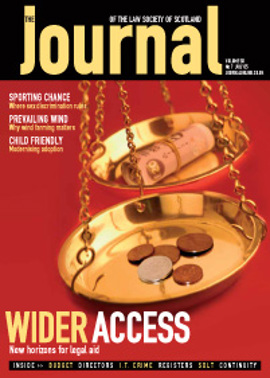SDLT: getting it right

The letter pages of the various law journals and even the national newspapers are testimony to the fact that solicitors are not enamoured with the still relatively new stamp duty land tax (“SDLT”). The time it takes to complete the various SDLT forms is probably the major complaint that anyone that has to deal with SDLT has.
It is widely accepted that the SDLT legislation was rushed through and as a result contained numerous errors and omissions. The fact that the original legislation was poorly drafted has meant that it has already been subject to major amendment. This has not made it any easier for solicitors to understand the legislation as they have in effect been trying to hit a moving target.
So what are your options if you have an SDLT question and/or need help completing one of the various SDLT forms?
Little help from the helpline
Notwithstanding the major problems with the initial legislation, for the majority of transactions SDLT is not much of an issue. A straightforward purchase, lease or assignation rarely causes serious problems and in any case the guidance notes for the various SDLT forms cover the basic issues pretty well. The online facility for completing SDLT forms has also made it easier to complete the forms as more information is given by way of drop down boxes.
This site can be found at www.hmrc.gov.uk/so/online/welcome.htm.
You may be aware that Her Majesty’s Revenue and Customs (“HMRC”), the new joint body for the Inland Revenue and Customs and Excise, was to introduce in April of this year an online facility that would have allowed for the online submission of SDLT forms. Anyone following the progress of this new tax since its introduction in December 2003 will not be surprised to hear that HMRC has been unable to get the submission part of this system to work. It is unlikely to be ready for a number of months.
If you have a question that is not covered in the guidance notes, one possible source of help is the SDLT enquiry line. The telephone number for this is 0845 603 0135. Opening hours are 8.30am to 5pm, Monday to Friday. However, the quality of response does vary greatly and in any case any answer given cannot be relied on. Also the enquiry line only deals with the basics of SDLT. If the person that you speak to is unable to answer your question, it is likely that you will be told to put your question in writing. (I will come back to SDLT written enquires later in this article.) If you have tried the helpline you are also likely to be aware that it is sometimes next to impossible to get through to someone.
No longer a soft touch
Two other options are the Stamp Taxes website www.hmrc.gov.uk/so/index.htm, and the SDLT Manual www.hmrc.gov.uk/manuals/sdltmanual. The website and the manual are improving but they are still a long way from being a comprehensive guide to SDLT.
Another option is the excellent SDLT frequently asked questions section of the Registers of Scotland website, www.ros.gov.uk/solicitor/faqs.html.
There will though be occasions where the SDLT helpline cannot answer your question even if you can get through, and you will also not be able to find an answer on the stamp taxes website or in the SDLT manual.
In this situation the first step is to write to the Complex Transactions Unit (“CTU”) of the Stamp Taxes Office. The CTU is based in Manchester at Stamp Taxes Complex Transactions Unit, Upper Fifth Floor, Royal Exchange, Exchange Street, Manchester M2 7EB (DX 719821 Manchester 2).
I wrote regularly to the CTU when SDLT was first introduced. Although the response could not be relied on they pretty much told you everything you needed to know. However, the form of response received from CTU changed when HMRC’s “soft touch” approach to SDLT ended last July. The CTU now rarely answers questions on an informal basis. The CTU instead informs you that if you want HMRC’s opinion on the application of the SDLT legislation to a specific transaction you need to make a formal request to it under Code of Practice 10 (“COP 10”). COP 10 can be found at www.hmrc.gov.uk/pdfs/cop10.htm.
Send for a COP
If you receive a response such as this from the CTU you then have to decide whether a request for a COP 10 ruling is justified. The main difference between an informal letter to the CTU and a formal request for a COP 10 ruling, besides the amount of work involved and the resultant cost to the client, is that you can rely on the COP 10 ruling given by HMRC. That gives you and your client certainty as to the SDLT implications of the transaction.
The COP 10 application must be in the format outlined in COP 10 and must include the full particulars of the transaction, your opinion of the tax consequences, an explanation of the particular points of difficulty and details of the tax legislation that you consider to be relevant. A request for a COP 10 ruling is also sent to the CTU.
One problem with requesting a COP 10 ruling is the fact that HMRC is struggling to issue COP 10 rulings before completion because it only has a handful of people dealing with COP 10 matters. This means in practice, if you want a response from HMRC before completion, that you must ensure that your COP 10 request is with HMRC at least four weeks and if possible six weeks before the transaction is due to complete.
If HMRC is unable to provide you with a ruling before your transaction is due to complete and the clients decide that they still want to go ahead despite the SDLT uncertainty, HMRC will automatically open a formal enquiry into the SDLT return that you submit. This is effectively a continuation of the request for a COP 10 ruling. A COP 10 ruling will not be given if requested after an SDLT return has been submitted.
Not out of the woods
If there is a problem with an SDLT form, HMRC will send both the solicitor and the client a form SDLT8. The SDLT8 indicates which items of information are missing or unclear. When this procedure was first announced it was suggested that most of these queries could be dealt with over the phone. This has not turned out to be the case. In most cases HMRC insists that the purchaser also signs the SDLT8. This can lead to problems as the 30 day period for submitting the SDLT return continues to run.
SDLT has caused the legal profession a great many problems in the last 18 months. As we all know, getting SDLT right is not easy. It takes a lot of time to complete the forms. It takes even more time to sort out a point of uncertainty. It is also not uncommon to be issued with an SDLT8 (notice indicating that there is a problem with your SDLT return) even though you have completed the form correctly. The fact that the Government’s income from the various stamp taxes is increasing by tens of millions of pounds each year does not help matters. By putting some of this income into improving the helpline and the CTU, the Government and HMRC might go some way towards getting their SDLT act together.
James Aitken, Tax Associate, Bell & Scott LLP
For Mr Aitken’s views on what could be done to improve the running of SDLT in Scotland, see barcoding article.
In this issue
- Commissioner: Public Authorities must do more
- Supporting legal aid
- No country cousins
- Making the money go further
- Adopting a new approach
- Gordon giveth and Gordon taketh away
- A blow for the future
- A Wie hint of change?
- Raising the bar
- The IT crimewave
- The directing mind
- Going through the motions
- Planning in the park
- Always look on the bright side
- Scottish Solicitors' Discipline Tribunal
- Website reviews
- Book reviews
- The race to the registers revisited
- SDLT: getting it right
- SDLT: barcoding
- Business sense






